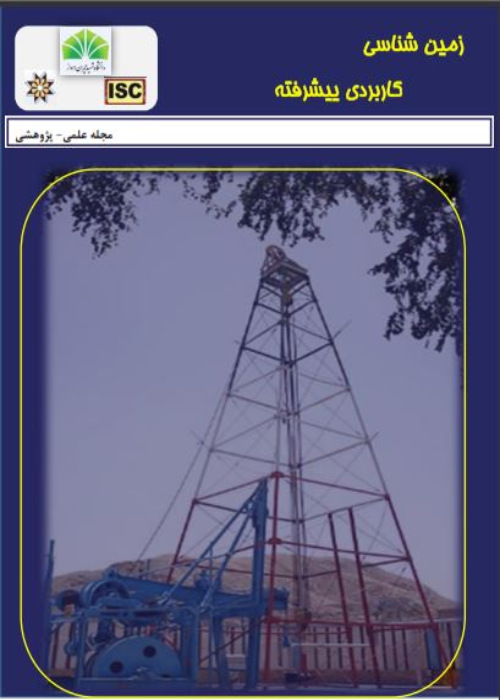Investigation of scale effect in the amount of water leakage from dam reservoir and abutments (case study: Beheshtabad Dam)
1- Introduction For a dam project in the karstic areas, the most important parameter is the hydraulic conductivity values which are necessary for determining the amounts of leakage from its reservoir and abutments However, secondary porosity and flow networks can cause heterogeneity and anisotropy in karst fields, leading to changes in hydraulic conductivity values and then significant differences in leak calculation values due to scale changes. Limestone formation in a regional scale is generally heterogeneous, and the heterogeneity of hydraulic conductivity (Karami 2002) usually specify the value of heterogeneity in karstic aquifers Kiraly (1975) investigated karstic aquifers and fractures in the Jura Mountains in Switzerland. He reported that the sub-local scale to the well-scale and the great permeabilities on the regional scale are related to karstic conduits and increase hydraulic conductivity. Rovey and Cherkauer (1995) measured the hydraulic conductivities of five hydrostratigraphic carbonate units at different scales and reported that the values of hydraulic conductivities show direct proportionality with the measurement scales. Sauter (2005) studied the various methods, sub-local to regional scales, for determining the permeability in a karstic environment. He mentioned that the various hydraulic conductivities in different scales could be due to the spatial organization and the degree of networking of the drainage system (Sauter 2005). Other hydrological and geological studies have investigated the relationship between scale with values of hydraulic conductivities in fractured rocks (Illman 2007) and sedimentary formations (Chapuis 2010, Galvão et al. 2016). The main objective of this study is an investigation of the scale effect on the amount of water leakage from the reservoir and the dam abutments in the karstic area. We selected the Beheshtabad for the case study of this issue. 2- Methodology Beheshtabad dam is double-arch dam with a height of 180 meters and the reservoir volume of 1050Í106 m3. The dam is situated on the Beheshtabad River with an approximately 33 m3/s flowrate. The right side of the reservoir is in contact with karstic limestone-dolomite of the Sangvil anticline named Jahrom- Asmari Formation with a thickness of about 700 meters. Determining the amount of leakage from the reservoir requires an accurate estimation of the hydraulic conductivity according to the contact scale with the karstic aquifer. The values of hydraulic conductivities have been measured in Jahrom-Asmari Formation of the right-side reservoir using various methods in three scales, sub-local, local and regional scales. We used the Slug and lugeon tests in sub-local scales and conducted simultaneous measurements of spring discharge and boreholes water levels such as pumping wells in the local scale. Also, hydraulic conductivity in the regional scale determined by Recession curve and Darcy method. Finally, the amount of leakage was calculated in different scales and compared based on the hydraulic conductivity values of different scales. 3- Findings The hydraulic conductivity has been calculated on a different scale with a related test for limestone aquifer on the reservoir’s right-side. The values of hydraulic conductivities are not the same in different methods, and it is in the range of 2.1×10-6 to 1.6×10-4 m/s (Table 1). The lowest hydraulic conductivity belongs to a slug test conducted on a sub-local scale, and the highest hydraulic conductivity is for recession curve and Darcy method in regional scale. Also, the spring discharge method and the water levels of boreholes as a pumping well in the local scale estimates the values of hydraulic conductivities. The calculated hydraulic conductivities on the regional scale are about 70 times higher than those for the sub-local scale, which is related to the effect of scale in the karstic environments. According to the results, experiments with a radius of greater than 500 meters will determine the equivalent volume of hydraulic conductivity to the karstic mass region. Table 1. Calculated hydraulic conductivity value using different methods Methods KMIN (m/s) KMAX (m/s) KRE (m/s) PACKER TEST 1.00E-05 1.00E-07 3.20E-06 SLUG TEST 1.10E-06 3.30E-06 2.10E-06 DARCY 1.00E-04 1.30E-04 1.20E-04 RORABAUGH 1.41E-04 3.60E-04 1.60E-04 MILANOVIC 4.10E-05 2.00E-04 8.00E-05 Seep 2D software determined the leakage value for the northern limb to the downstream and southern limb. The amount of leakage varies due to changes in values of hydraulic conductivities. The amount of leakage calculated based on the average reservoir cross-section with a limestone aquifer at sub-local, local and regional scales are 0.3, 3.9, and 5.4 to 8.1 m3/s, respectively. Such differences in the estimation of leakage are related to the scale effects on the heterogeneity of karstic areas. Hydrogeological studies indicate that the Beheshtabad reservoir is contacted regionally with the right-side limestone aquifer; therefore, the leakage amount should be modeled based on the regional hydraulic conductivity. According to the regional scale, hydraulic conductivity varies between 1.1×10-4 to 1.6×10-4 m/s. Therefore, the leakage amount from the dam reservoir will be between 6.3 m3/s and 8.1 m3/s (Fig. 1). Fig 1. Leakage amount based on regional scale hydraulic conductivity 4-Conclusion For determining the amount of dam reservoir leakage in the karstic areas, the most critical parameter is the value of hydraulic conductivity that changes with the measuring scale. When reservoir and abutment of the dam contacted with karst, some methods for determining the regional hydraulic conductivity such as dye tracing, the Darcy method, and the recession curve method are more accurate to estimate the leakage amount. If the reservoir contact is local, the pumping test is more accurate for determining the leakage value. Also, in the sub-local contact scale, lugeon, injection, and slug experiments are more accurate methods in terms of determining leakage amount. In karstic formations, the scale effect is one of the most important factors for reservoir considering in the stage of site selection of the dam. Therefore, the choice of the dam axis can be carried out in places where the reservoir and abutments of the dam are not in contact with the karst network as far as possible. References Chapuis, R.P., 2010. Permeability scale effect in sandy aquifers: A few case studies. Proceedings of the18th International Conference on Soil Mechanics and Geotechnical Engineering, Paris Galvão, P., Halihan, T., Hirata, R., 2016. The karst permeability scale effect of Sete Lagoas, MG, Brazil. Journal of Hydrology 532, 149-162 Illman, W.A., 2006. Strong field evidence of directional permeability scale effect in fractured rock. Journal of Hydrology 319 (1-4), 227-236 Karami, G.H., 2002. Assessment of heterogeneity and flow systems in karstic aquifers using pumping test data. Ph.D. thesis, University of Newcastle Kiraly, L., 1975. Rapport surl’etat actuel des connaissances dans le domaine des caracteres physiques des roches karstiques. In Hydrogeology of Karstic Terrains (eds Burger A and Dubertret L). International Union of Geological Sciences, Series B, 3:53–67 Rovey, C.W., Cherkauer, D.S., 1995. Szxcale dependency of hydraulic conductivity measurements. Groundwater, 33(5), 769-780 Sauter, M., 2005. Scale effects of hydraulic conductivity in karst and fractured aquifers. Geophysical Research Abstracts, Accepted 28 April 2005, https://www.cosis.net/abstracts/EGU05/07748/EGU05-J-07748.pdf
- حق عضویت دریافتی صرف حمایت از نشریات عضو و نگهداری، تکمیل و توسعه مگیران میشود.
- پرداخت حق اشتراک و دانلود مقالات اجازه بازنشر آن در سایر رسانههای چاپی و دیجیتال را به کاربر نمیدهد.



